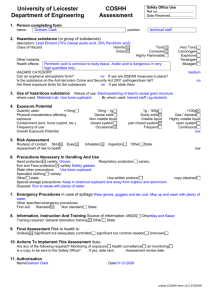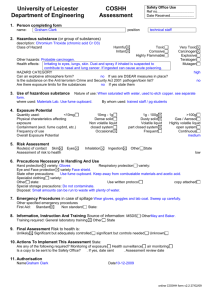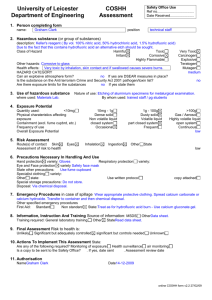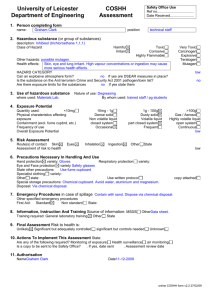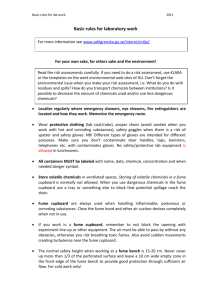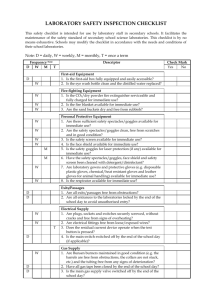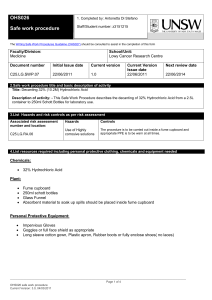Appendix X
advertisement
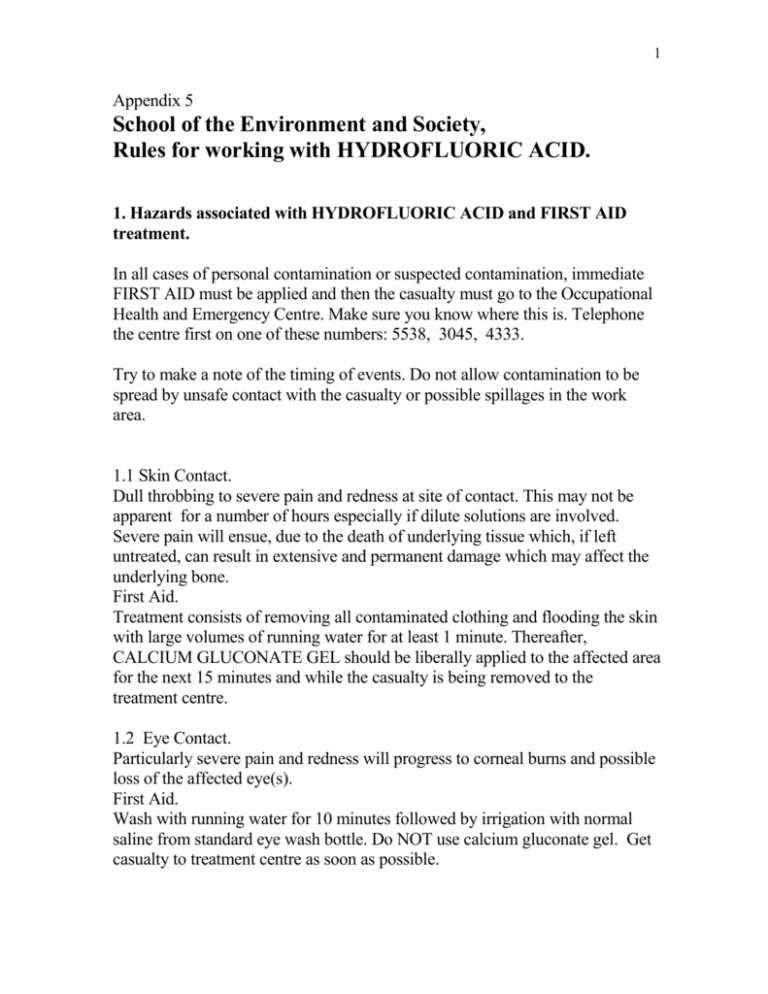
1 Appendix 5 School of the Environment and Society, Rules for working with HYDROFLUORIC ACID. 1. Hazards associated with HYDROFLUORIC ACID and FIRST AID treatment. In all cases of personal contamination or suspected contamination, immediate FIRST AID must be applied and then the casualty must go to the Occupational Health and Emergency Centre. Make sure you know where this is. Telephone the centre first on one of these numbers: 5538, 3045, 4333. Try to make a note of the timing of events. Do not allow contamination to be spread by unsafe contact with the casualty or possible spillages in the work area. 1.1 Skin Contact. Dull throbbing to severe pain and redness at site of contact. This may not be apparent for a number of hours especially if dilute solutions are involved. Severe pain will ensue, due to the death of underlying tissue which, if left untreated, can result in extensive and permanent damage which may affect the underlying bone. First Aid. Treatment consists of removing all contaminated clothing and flooding the skin with large volumes of running water for at least 1 minute. Thereafter, CALCIUM GLUCONATE GEL should be liberally applied to the affected area for the next 15 minutes and while the casualty is being removed to the treatment centre. 1.2 Eye Contact. Particularly severe pain and redness will progress to corneal burns and possible loss of the affected eye(s). First Aid. Wash with running water for 10 minutes followed by irrigation with normal saline from standard eye wash bottle. Do NOT use calcium gluconate gel. Get casualty to treatment centre as soon as possible. 2 1.3 Inhalation. Mild effects are coughing and choking, and severe poisoning causes severe shortness of breath with congestion of the lungs, muscle spasms and convulsions. First Aid. Remove casualty to fresh air. Resuscitate if necessary using appropriate equipment. Get casualty to treatment centre as soon as possible. 1.4 Ingestion. Mild effects are nausea, vomiting, diarrhoea and abdominal pain. Severe poisoning causes shock, blurred vision, muscle spasms, shallow breathing and convulsions. Kidney failure may occur later. First Aid. Give milk by mouth. Calcium Gluconate solution if available. Get casualty to treatment centre as soon as possible. 2. General work practice and Rules. 2.1 If there is any possible alternative to Hydrofluoric Acid, use it. 2.2 Due to the toxic and corrosive nature of Hydrofluoric Acid (HF), the use is strictly controlled, and these guide-lines must be followed, both for your own safety and the safety of others who may have to attend to you in an emergency. These guide-lines are for work using HF in the Palaeoecology Laboratory, Room No. 233, in the Department of Geography. Only authorised personnel may use HF Active work using HF may only be carried out during the hours that the Occupational Health and Emergency Centre is open; the hours are 9am to 5pm during term time and 9am to 4pm in the vacation, on normal working days. Work after hours, at the weekends, and on public holidays is not permitted. 2.4 Hydrofluoric Acid is more corrosive than normal acids so care should be taken in the selection of laboratory equipment to be used, making sure that it is compatible with the acid and any other reagents used. It is neutralised by using calcium compounds. CaF2 is stable, inert and less soluble than CaCO3. It occurs naturally as a mineral. 2.5 Before any work commences, you must inform a designated person of your intentions, and that person must remain on call in case of an emergency, and be 3 prepared to make checks from time to time to see that work is proceeding normally. The person must be fully acquainted with these rules and safety requirements governing the use of HF. When the work is completed, that person must be informed that the work has terminated. 2.6 All work must be performed in the fume cupboard numbered FC 035. You must not take unsealed containers of HF from outside the confines of the fume cupboard, especially the concentrated (fuming) reagent. You must be familiar with fume cupboard working practices and attend a course on this topic. You must establish that the fume cupboard is in full and correct (safe) working order. The same applies to all equipment to be used in the fume cupboard; check the compatibility with fume cupboard power supplies etc. In order to neutralise instantly any spills, the floor of the fume cupboard should be liberally sprinkled with lime (CaO), slaked lime (Ca(OH)2), or best, calcium carbonate (CaCO3) powder. Alternatively, a tray may be used provided it is more than large enough to contain all equipment, without being cluttered. A beaker of the powder should be available in the fume cupboard for spill control and postwork neutralisation of excess acid. 2.7 Protective clothing must be worn at all times. This must include gauntlet gloves, rubber or synthetic impermeable apron, eye and face protection in the form of a full visor and face mask. Protective equipment should be checked before use. There should be no part of the body exposed to possible splashes. Any clothing exposed to possible splashes should be washable. In an emergency, contaminated clothing will have to be removed, so for the sake of modesty, you should consider having spare clothing to hand. 2.8 Temporary notices must be put up on the outside of the main laboratory door, barring entry to everyone except authorised personnel. Do not let people interrupt you in your work. 2.9 Make sure that there is a clean and uncluttered sink available for use in an emergency, so that extensive irrigation may be carried out, and to this end, see that a spray or flexible rubber tube is attached to the cold water tap. Make sure that there is a plentiful supply of Calcium Gluconate gel, and check it is within the 'use-by' period. Make sure that eye irrigation equipment is available and that sealed saline solution bottles (Medical) are to hand. Make sure that there is a clearly marked 'Rescue Box' containing a complete set of protective gear set in 4 a prominent position not too close to the work area, for use by the person who may have to come to your assistance. 2.10 A clearly marked bucket half full of a solution of calcium hydroxide (slaked lime, Ca(OH)2) should be prepared for emergency neutralisation of contaminated clothing and equipment, and post-work washing of gloves and equipment. 2.11 Plan your work schedule and be realistic about the amount of work that you will be able to achieve in the available time; do not be too ambitious. Assemble all the equipment you will be needing and carry out all the safety precautions first, before commencing any work or getting any bottles of HF out of storage. Avoid the necessity of removing and replacing protective clothing during the course of the work and plan your work accordingly. 2.12 When the work has been completed, decontaminate all equipment that has been in contact with the HF and any equipment that may have been affected by spray and splashes and possibly condensation, including the gloves (before taking them off!) and apron, even if you think they have not been contaminated. You can use the calcium hydroxide solution for this purpose, but remember that this solution is mildly alkaline (caustic). Excess HF should be neutralised in a plastic beaker containing calcium carbonate or calcium hydroxide. 2.13 In an emergency, DO NOT PANIC. For minor incidents like spills within the fume cupboard, put into effect immediate decontamination, using the powders and solutions available. For more serious spills extending outside the fume cupboard, neutralize at once with the lime or carbonate powder, summon help before any other action is taken, and then make a careful joint appraisal of the situation. For spills of concentrated fuming acid outside the confines of the fume cupboard, be prepared to call for professional help and raise the alarm. 2.14 For personal contamination, apply immediate First Aid as indicated, then fetch help and then go to the Occupational Health and Emergency Centre, telephoning them first. Although the symptoms described for HF poisoning are drastic, prompt and efficient First Aid will reduce the possibility of the symptoms appearing. Your response will be far quicker if you know the action to take, so make sure you remember the First Aid routines. If you do get splashed or etc., avoid contaminating other people and avoid carrying the contamination further afield. Try to make a note of the time of the incident and inform people of the state of the work area. 5 Check list of Actions to be taken before carrying out HF work. 1 Inform a 'responsible' person that work is to proceed. 2 Check fume cupboard for correct operation. 3 Get out safety kit and emergency response kit and check the contents. 4 Check gel use-by date. 5 Put up temporary notices. 6 Make sure sink is clear and clean. 7 Prepare bucket of lime solution. 8 Make sure there is an adequate supply of lime both for emergency use and final clearing up operations. 9 Assemble all equipment ready for use. If any of the above cannot be completed for any reason, you should not proceed with the planned work. 10 After the work is completed, dispose of unused acid safely. 11 Decontaminate all utensils and protective equipment and store it. 12 Inform the 'responsible' person that work has been finished. 13 Remove temporary "Work in Progress" notices.
